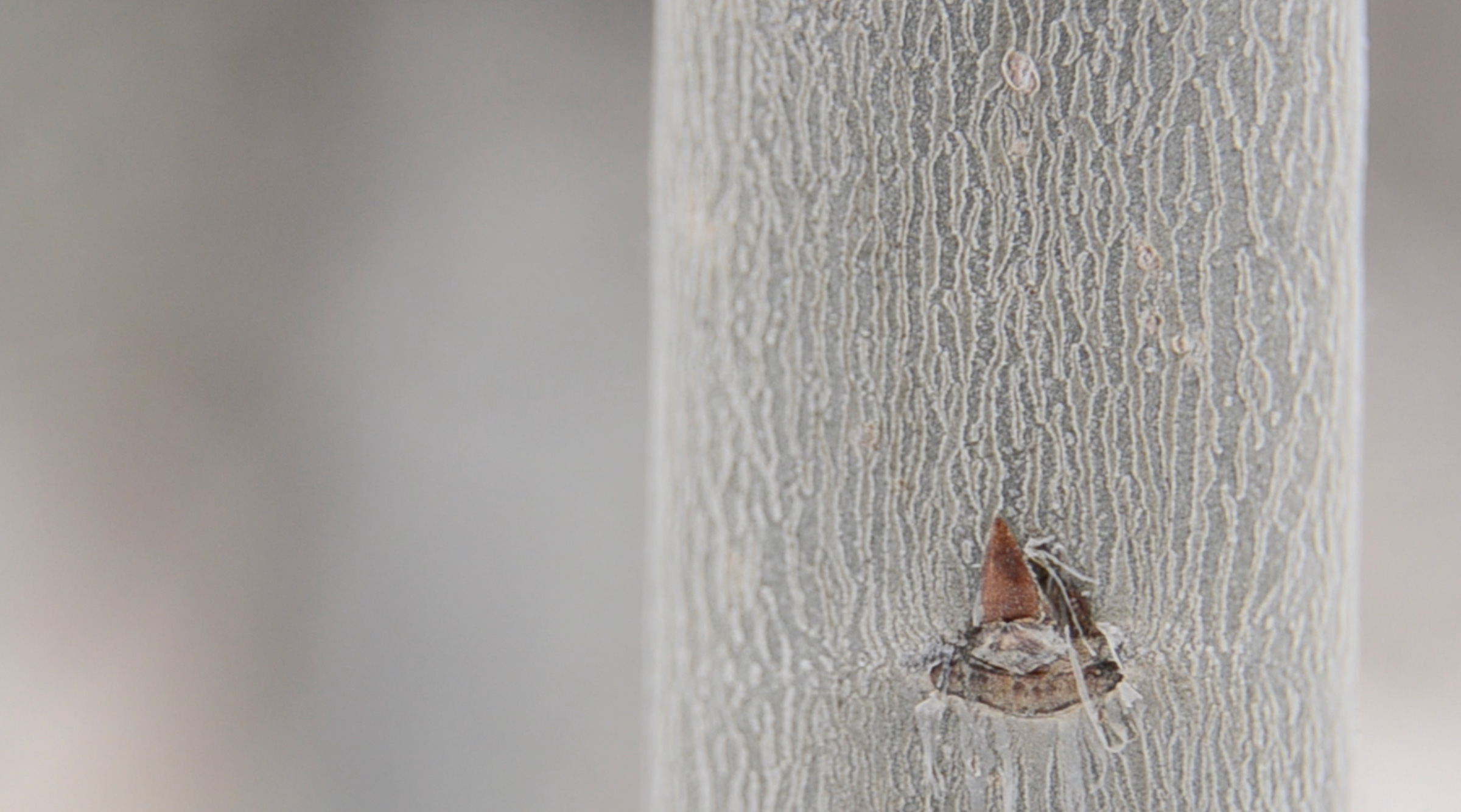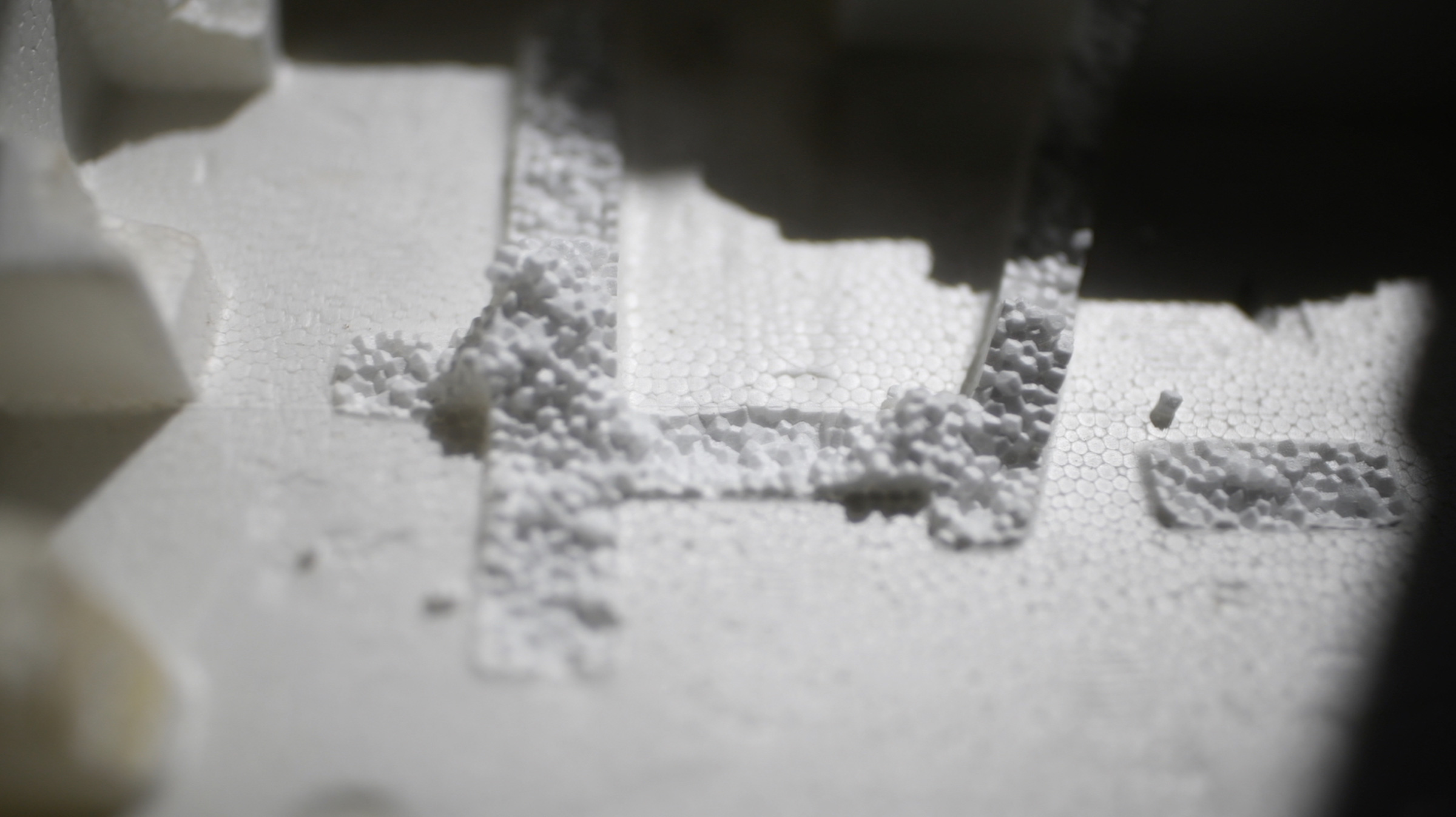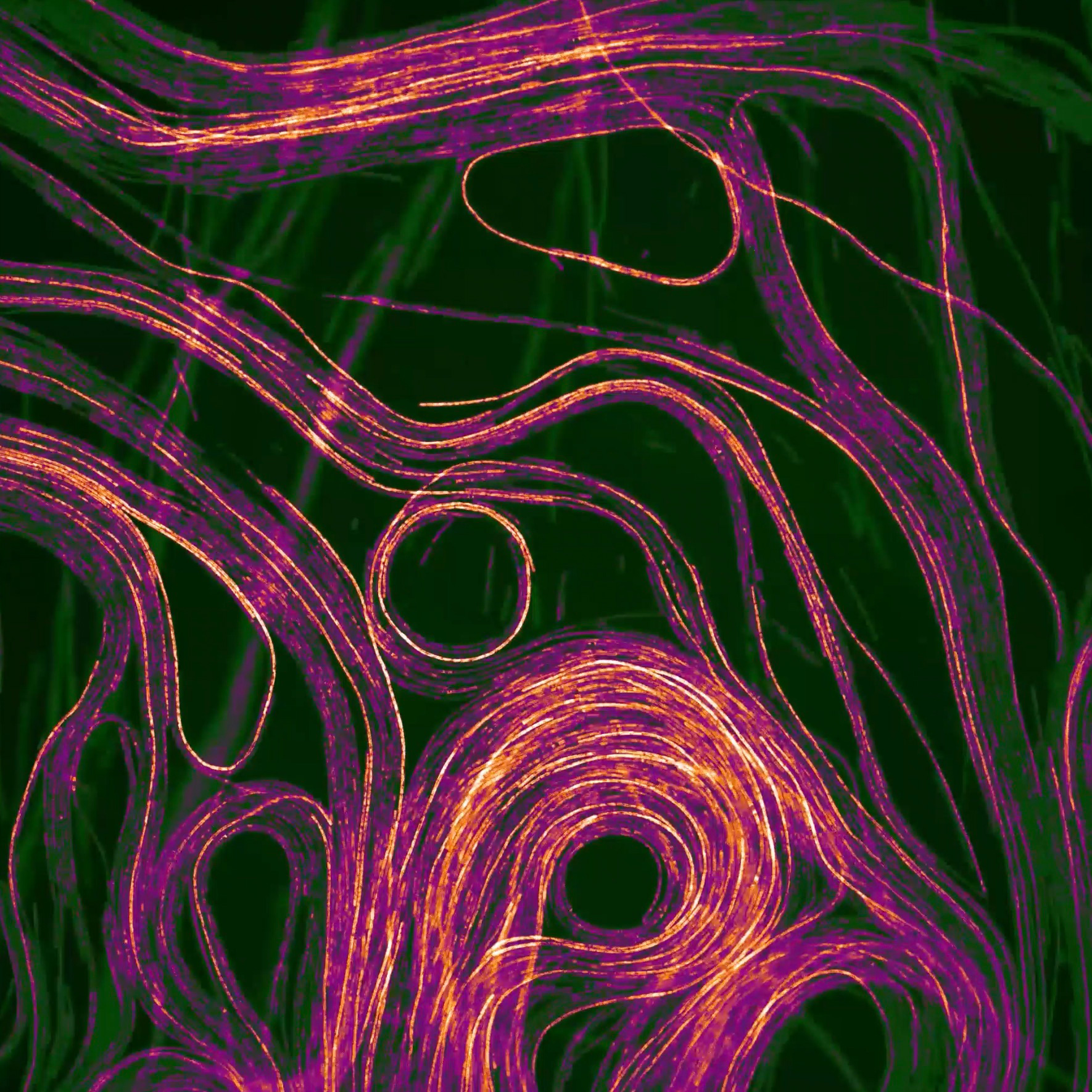Beginning in Medias Res
- Erin Espelie
Why does the quaking aspen make sugar not only in its leaves but also in its bark? How do the larvae of darkling beetles biodegrade Styrofoam in their gut? Do red foxes detect magnetic north as they hunt for rodents in deep snow?
Tree, insect, vertebrate.
Populus tremuloides, Tenebrio molitor, Vulpes vulpes.
These are categorical beginnings, ones I have chosen to delve into over the last several years. Each question, each binomial species, has served as an entryway for me into a lens-based study. Discrete answers have been less important than following the elusive aspects of each new question seeping up from the muddy residue of the last. Ending these sets of experiments has entailed distilling results into words, sounds, images.
Are these pursuits born of science or art? Can my efforts be accurately bisected? Should they be? Despite resisting codifications, I find myself regularly forced to issue judgment. Yet science and art, so often placed in false opposition, oscillate around the same impulse: curiosity. Nearly every other worldly pursuit involves endgame motivations such as seeking justice or making money, recording history or assessing humanity, satisfying a hunger or extracting a resource.
Art and science, in my estimation, align more than they differ. Both ask open-ended questions ad infinitum. Both frequently demand new experimental designs and provoke conversations, historical and contemporary, with others in their fields. Their investigators tend to work iteratively in search of new perspectives, triaging an enormous quantity of material deemed inelegant for public display, throughout successive processes. Ultimately, they share a collective abhorrence for reductionism, refusing to be limited by categorical, catchall terms like the arts and the sciences.
Over the years I have amassed a collection of quotations from various thinkers who, according to personal passions and collective times, have placed art and science either in alliance or opposition. One of my favorites comes from physician-playwright Anton Chekhov, who personified scientific medicine as his “lawful wife” and the literary arts as his “mistress,” writing to a friend that, “[W]hen I get tired of one I spend the night with the other. Though it is irregular, it is less boring this way, and besides, neither of them loses anything through my infidelity” (Schwartz 2014, 213).
In my early twenties, I clung to this quote as an articulate justification for why I straddled two identities—scientist and artist. The arts were indeed more illicit and seductive than my more stable, socially acceptable, and socially responsible job in the sciences, which I felt obligated and duty-bound to hold. But I agreed with Chekhov that neither entity suffered—in fact they benefited—from the other’s presence, together enriching my life.
Later, as I sat and squirmed more squarely within society’s definition of an artist, I sought comfort from, among others, author George Eliot, who wrote at the outset of her 1876 novel, Daniel Deronda:
Men can do nothing without the make-believe of a beginning. Even Science, the strict measurer, is obliged to start with a make-believe unit, and must fix on a point in the stars’ unceasing journey when his sidereal clock shall pretend that time is at Nought. His less accurate grandmother Poetry has always been understood to start in the middle; but on reflection it appears that her proceeding is not very different from his; since Science, too, reckons backwards as well as forwards, divides his unit into billions, and with his clock-finger at Nought really sets off in medias res (2002, 1).
Despite the tired gender split, the idea that Science is a rather oblivious pretender amuses me. The assessment that science cannot escape its own subjectivity—and the trappings of requisite fiction—readily fits my critique of rigid scientific epistemologies. I also admire Eliot’s untraditional casting of Poetry as older, wiser, and more assured in her methods—a trusted companion whom we expect to entwine us in tales of enticing confusion.
We all love intrigue—which is why Albert Einstein called mystery “the source of all true art and science” (1931, 5). Mystery awakens our curiosities, which then inspire creativity, the fundamental aspect of expanded exploration. Astronaut Mae Jemison, who also credits creativity as a yoking force, states that the arts and sciences are “manifestations of the same thing . . . avatars of human creativity” (2002). Jemison’s personification is refreshingly open-ended, allowing for a multitude of individual imaginations to fill in the personal identities and infinite aspects of science and art.
Countless others have puzzled over how to reconcile the nuanced differences and similarities in these two fields, from Anna Atkins, Erasmus Darwin, and Leonardo da Vinci to Athanasius Kircher, Maria Sibylla Merian, and C.P. Snow. Recent scholars make this list, too. In a 2022 interview, artist Haroon Mirza offered this about his solar-powered installation, stone circle, in the Texas desert:
[T]hat’s the powerful thing about art: artists being able to propose things that actually provide practical solutions . . . or open up a new awareness [. . .] Sometimes it happens as a very programmed part of the work [. . . but] the majority of the time it comes out of an accidental side effect (Buck 2022).
Mirza is making the implicit comparison of art to science in both functional and innovative realms. Although I don’t fully agree with the validity of that metric—utility cannot always be quantified or identified in advance—I respect its importance for many. Alternately, I know how joyful the serendipity found through unfettered experimentation can be in any field. So I appreciate science writer Natalie Elliot’s perspective on how both art and science affect our sense of greater purpose:
A lot of great art helps us deal with the tears in the fabric of how we live [. . . so that we can] start to imagine responses to things that science tells us. [. . .] Great artists can give us ways of trying out different stories and ways of envisioning different responses to our existential uncertainty, which I think is always there if we just look around a little bit. And science often helps us see (Bogaev 2021).
In 2017, I co-founded NEST (Nature, Environment, Science & Technology) Studio for the Arts on the University of Colorado Boulder campus with my colleague Tara Knight. The verb “to nest” is rooted in identifying categories of containment, in the style of taxonomist Carl Linnaeus, maximizing efficiency while maintaining autonomy. “Nest” is also a noun describing a constructed home. At the very minimum, NEST was meant to be a place for shared observation, in the spirit of scholars Lorraine Daston and Elizabeth Lunbeck who wrote, “Observation has always been a form of knowledge that straddles the boundary between art and science [. . . and it offers] new knowledge in the most unexpected places” (2011, 7-8).
NEST was designed to explore our current uncertainties, to study what might be gained from more collaboration between disparate fields. A 2016 report in the scientific journal Nature extolled the benefits of art-science engagements, ranging from breakthroughs in research and the creation of art, to improved communication skills and greater student commitment to their education and campus communities (Eldred 2016, 125-26). Frequently, artists are encouraged to be inspired by scientific research to create their works and, inversely, scientists feel pressure to artfully translate the complexity of their research to the public, typically through data visualizations. NEST Studio for the Arts embraces empiricism within these existing models while encouraging alternate anatomies for addressing complex, integrated understandings of humankind and our environment. By focusing directly on how disciplines interact and how methodologies might be co-created and shared, the students at NEST have found freedom to define their work outside the margins of traditional disciplines.
Over the last 5 years, NEST has supported more than sixty collaborators who have delved into educational traditions, explored ontologies, and gained expertise through broadly defined art-science projects. A ceramicist experimented with a mechanical engineer to create a passive air-filter sculpture; a philosopher collaborated with an ice scientist to create wood-block prints about Baffin Island and rising sea levels; a mycologist and a filmmaker co-directed a film about cell growth; a mathematician partnered with musicians; and so on. We have seen an astonishing array of ways that art and science, working together, can act as catalyst, beacon, icon, and surrogate for a subject, an idea, a cause. They can activate change and sway opinions. The only requirement for results appears to be persistent, creative inquiry in search of ever-shifting perspectives.
I still oscillate—without much predictability in my tempo—between identifying as a scientist or as an artist. One month, my work in a cyanobacteria laboratory takes precedence; in another, a narrative cinematic exploration intercedes. Ultimately, I care little for labeling. Instead, my focus is on choosing where to point my clock-finger next, and then beginning.
References:
Bogaev, Barbara. 2021. Interview with Natalie Elliott. “Episode 158: Shakespeare, Science, and Art.” January 5, 2021. Shakespeare Unlimited. Produced by Richard Paul. Podcast, Soundcloud audio, 33:22. folger.edu/shakespeare-unlimited/science-art-natalie-elliot
Buck, Louisa. 2022. “Haroon Mirza: The question I’m asking is, What kind of species are we?” The Art Newspaper, January 13, 2022. theartnewspaper.com/2022/01/13/haroon-mirza-the-question-im-asking-is-what-kind-of-species-are-we
Eldred, Sheila Mulrooney. 2016. “Art-Science Collaborations: Change of perspective.” Nature 537, (August): 125-126. doi.org/10.1038/nj7618-125a
Daston, Lorraine, and Elizabeth Lunbeck, eds. 2011. Histories of Scientific Observation. Chicago: University of Chicago Press.
Einstein, Albert et al. 1931. Living Philosophies. United States: Simon and Schuster.
Eliot, George. 2002. Daniel Deronda. New York: Penguin Random House. penguinrandomhouse.ca/books/260975/daniel-deronda-by-george-eliot/9780140434279/excerpt
Jemison, Mae. 2002. “Teach Arts and Sciences Together.” Lecture, TED2002, February 2002. ted.com/talks/mae_jemison_teach_arts_and_sciences_together/transcript?language=en
Schwartz, Robert S. 2004. “Medicine Is My Lawful Wife.” New England Journal of Medicine 351, no. 3 (July): 213-214.



